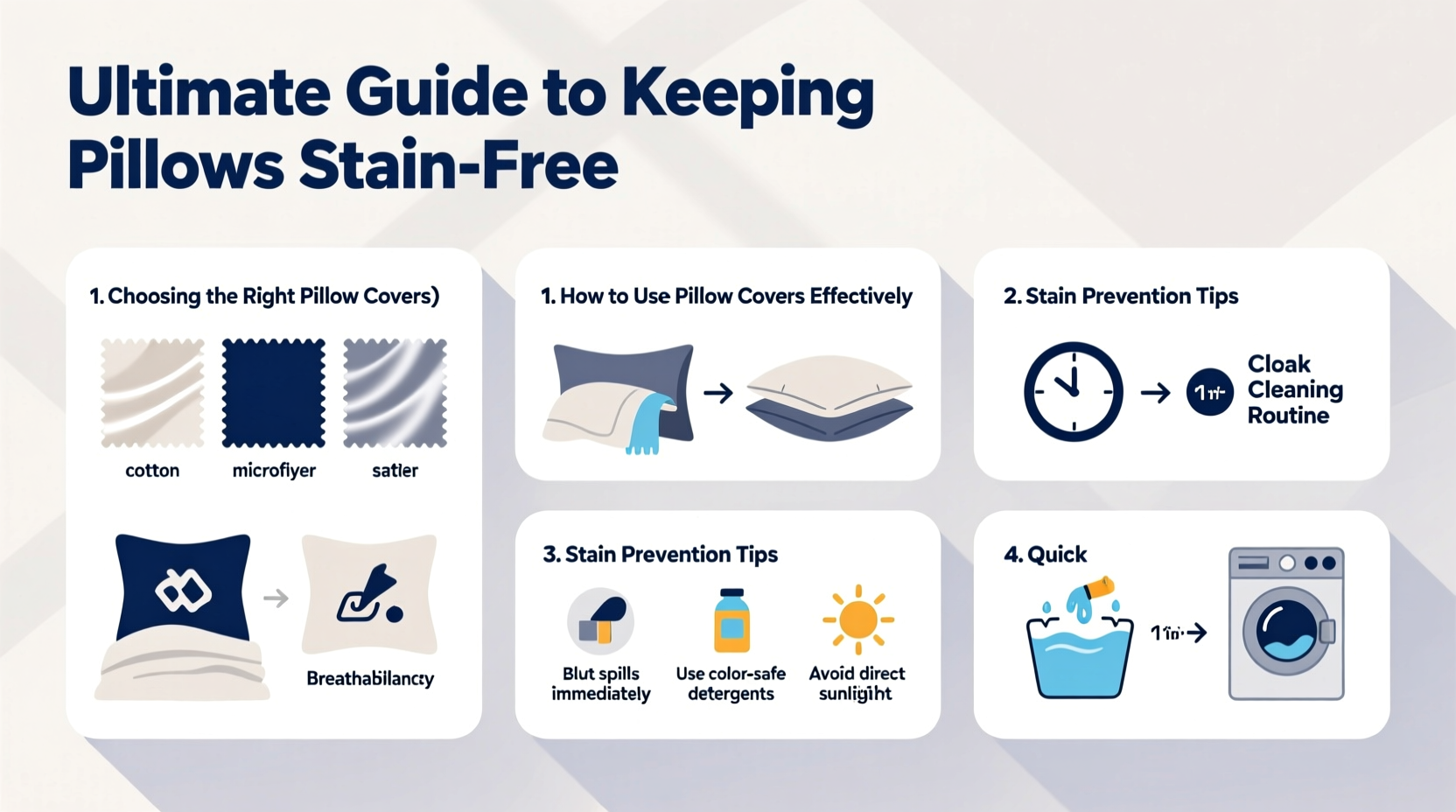Pillows are a silent cornerstone of restful sleep, yet they're often overlooked when it comes to maintenance. Over time, exposure to sweat, oils, saliva, and environmental debris can lead to unsightly stains, odors, and even microbial growth. While washing pillows helps, the real defense lies in prevention. The right pillow cover—used correctly—acts as a protective barrier that preserves both cleanliness and comfort. This comprehensive guide walks through everything you need to know about selecting, using, and maintaining pillow covers to keep your pillows pristine for years.
The Hidden Threat: What Stains Your Pillows?

Pillows absorb more than just head pressure. Every night, your body releases moisture through sweat and sebum (skin oil), while hair products, makeup, and dead skin cells transfer onto fabric surfaces. These organic materials create a breeding ground for bacteria, dust mites, and mold—especially in warm, humid environments. Without protection, these substances penetrate deep into pillow fibers, causing yellowing, odor buildup, and material degradation.
Memory foam and down pillows are particularly vulnerable due to their porous or fibrous structures. Once stained, full restoration is rarely possible. Prevention, not correction, is the key strategy.
“Most people don’t realize that pillow stains start forming within weeks of use. A quality cover isn’t optional—it’s essential for hygiene and durability.” — Dr. Lena Torres, Sleep Health Researcher at the National Rest Institute
Choosing the Right Pillow Cover: Materials That Work
Not all pillow covers are created equal. The best ones combine breathability, durability, and effective moisture resistance. Below is a comparison of common materials used in protective pillow encasements.
| Material | Pros | Cons | Best For |
|---|---|---|---|
| Cotton (Percale or Sateen) | Breathable, soft, machine-washable | Less waterproof; may require frequent washing | Daily comfort with light protection needs |
| Polyester Blend | Durable, wrinkle-resistant, affordable | Can trap heat; less breathable | High-use households or budget-conscious buyers |
| Terry Cloth | Highly absorbent, excellent sweat control | Thicker texture; may feel bulky | Night sweaters or hot sleepers |
| Waterproof Vinyl or PU Coating | Complete liquid barrier, hypoallergenic | Noisier, less breathable, can feel plasticky | Allergy sufferers, children, medical use |
| Bamboo-Derived Rayon | Soft, naturally antimicrobial, eco-friendly | More expensive; requires gentle washing | Sensitive skin, eco-conscious users |
How to Use Pillow Covers Effectively: A Step-by-Step Guide
A cover only works if used properly. Follow this sequence to maximize protection and longevity:
- Wash before first use: Remove manufacturing residues by laundering the cover according to care instructions.
- Insert carefully: Avoid sharp nails or jewelry that could snag delicate fabrics like bamboo or microfiber.
- Seal completely: If using a zippered encasement, ensure the zipper is fully closed to block dust mites and liquids.
- Layer smartly: Use the protective cover as a base layer, then add a decorative pillowcase on top for aesthetics.
- Rotate regularly: Have at least two covers per pillow to allow thorough drying between washes.
- Inspect monthly: Check for wear, tears, or lingering odors that suggest microbial growth.
When to Replace a Pillow Cover
Even high-quality covers degrade over time. Signs it's time to replace include:
- Fabric thinning or pilling
- Zippers that no longer close securely
- Yellow or gray discoloration after washing
- Musty smell despite cleaning
Real-Life Example: How One Family Reduced Allergy Symptoms
The Chen family struggled with recurring nighttime congestion and itchy eyes. Their 8-year-old daughter had diagnosed dust mite allergies, but symptoms persisted despite medication. After consulting an allergist, they discovered their pillows—though washed occasionally—had no protective encasements. They switched to zippered, hypoallergenic bamboo-based covers and began weekly laundering. Within three weeks, allergy flare-ups decreased significantly. The parents noted better sleep quality too, attributing it to fresher bedding overall.
This case illustrates that proper pillow protection doesn’t just prevent stains—it improves health and well-being.
Checklist: Maintain Stain-Free Pillows Year-Round
Use this checklist monthly to stay ahead of contamination:
- ✅ Wash pillow covers every 1–2 weeks in warm water
- ✅ Air out pillows weekly by placing near an open window (avoid direct sunlight)
- ✅ Vacuum pillows gently with a brush attachment every month
- ✅ Spot clean spills immediately with mild detergent and cold water
- ✅ Replace worn or damaged covers promptly
- ✅ Store spare pillows in breathable cotton bags, never plastic
FAQ: Common Questions About Pillow Covers
Can I use a regular pillowcase instead of a protective cover?
A standard pillowcase offers minimal protection. It shields against surface dirt but allows sweat and allergens to seep through. For true defense, use a dedicated zippered encasement designed for barrier protection, then place a regular case over it for comfort.
Do waterproof covers ruin pillow breathability?
Some do, especially older vinyl models. However, modern polyurethane (PU) laminated fabrics offer quiet, flexible waterproofing with improved airflow. Look for “breathable waterproof” labels and avoid PVC-based materials for sleeping comfort.
How often should I wash my actual pillow?
Experts recommend washing pillows every 3–6 months, depending on usage and material. Down and fiberfill pillows can usually be machine-washed (gentle cycle, low spin), while memory foam must be spot-cleaned only. Always check manufacturer guidelines first.
Final Thoughts: Make Protection a Habit
Keeping pillows stain-free isn’t about perfection—it’s about consistency. The small effort of using a quality cover and maintaining a simple cleaning routine pays off in cleaner sleep surfaces, reduced allergens, and extended pillow life. Think of your pillow cover as invisible insurance: it doesn’t change how you sleep, but it dramatically improves what you wake up to.
Start tonight. Inspect your current setup. If you’re relying solely on a decorative case, invest in a proper protective encasement. Choose one suited to your sleep habits—whether you run hot, have allergies, or simply want longer-lasting pillows. Then commit to a washing schedule that keeps everything fresh.









 浙公网安备
33010002000092号
浙公网安备
33010002000092号 浙B2-20120091-4
浙B2-20120091-4
Comments
No comments yet. Why don't you start the discussion?